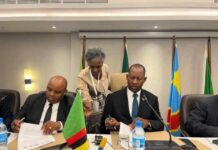
While the two regions’ poverty problems are difficult to compare, both places have ignored the needs of their struggling populations — until now.
This story is part of Governing‘s annual International issue.
Lusaka, the capital of Zambia, is laid out a lot like many cities in sub-Saharan Africa. There’s an urban core dating back to the colonial era. Then on the outskirts there are dozens of ramshackle squatter settlements. The traditional urban planning response to these slums has been to demolish them, often in the middle of the night.
Gilbert Siame is working hard to change that attitude. Siame recently launched a new master’s program in spatial planning at the University of Zambia. It’s the first program in Africa to fully incorporate acceptance of the “informal city” into its curriculum. The on-the-ground reality in Lusaka is that 70 percent of the city lives in unplanned slums without basic services. Siame’s goal is to produce a new generation of planners who not only acknowledge this but also work to improve the lives of the people living in these settlements.
Siame welcomed his first class into the two-year program in October. He has 18 students, a group that includes top planning officials for the local, provincial and national governments. For their first six-month “studio” — a hands-on learning experience — the Zambia chapter of Shack/Slum Dwellers International took them into a settlement called Kalikiliki.
Some in the class were uneasy about this. “Their training and experience tells them that informality needs to be erased,” Siame says. As the students began attending community meetings, visiting churches and talking to slum residents, they warmed up, ultimately producing a half-dozen plans for upgrading services such as water and waste collection. “They’re learning how to socially engage a community like that,” Siame says. “How do you speak in a language they understand so they can draw with you — that you formulate the plan together?”
The problems of vast unplanned squatter settlements can be hard to fathom in the United States. But you can find parallels if you think of Gilbert Siame’s quest as an effort to fill in a big blind spot in his country’s urban policy.
One of those parallels is the growing suburbanization of poverty. According to the Brookings Institution, America’s suburban poor population grew by 64 percent between 2000 and 2011 — more than twice the rate of growth seen in cities. Yet social services and public transit remain largely oriented toward city centers.
There’s a lot we still don’t understand about this phenomenon, especially when it comes to transportation. Researchers at Northeastern University recently surveyed Latinos in different parts of Massachusetts on how they get around. One intriguing finding was that one-sixth of respondents get around using “someone else’s car.”
“‘Someone else’s car’ is a mode of transportation that is not recognized in transportation planning in the USA,” says Stephanie Pollack, the center’s associate research director. “It shows how little the people who make decisions actually know about the lived experience of the people who use it.”
The slums of Lusaka are obviously quite different from U.S. suburbs. But it’s useful to remember that elements of the “informal city” exist here, too. And the only way local leaders can truly understand those things is to go into communities with an open mind, ask questions and listen carefully to the answers.


 JOIN DRIVERN TAXI AS PARTNER DRIVER TODAY!
JOIN DRIVERN TAXI AS PARTNER DRIVER TODAY!










